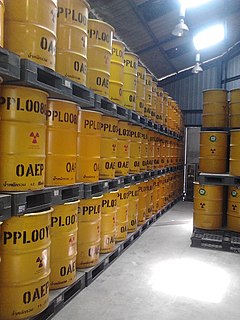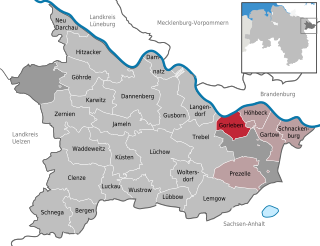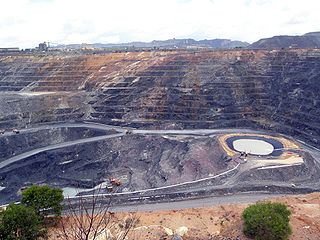Related Research Articles

Radioactive waste is a type of hazardous waste that contains radioactive material. Radioactive waste is usually a by-product of nuclear power generation and other applications of nuclear fission or nuclear technology, such as research and medicine. Radioactive waste is regulated by government agencies in order to protect human health and the environment.

The Yucca Mountain Nuclear Waste Repository, as designated by the Nuclear Waste Policy Act amendments of 1987, is a proposed deep geological repository storage facility within Yucca Mountain for spent nuclear fuel and other high-level radioactive waste in the United States. The site is located on federal land adjacent to the Nevada Test Site in Nye County, Nevada, about 80 mi (130 km) northwest of the Las Vegas Valley.

Low-level waste (LLW) is nuclear waste that does not fit into the categorical definitions for intermediate-level waste (ILW), high-level waste (HLW), spent nuclear fuel (SNF), transuranic waste (TRU), or certain byproduct materials known as 11e(2) wastes, such as uranium mill tailings. In essence, it is a definition by exclusion, and LLW is that category of radioactive wastes that do not fit into the other categories. If LLW is mixed with hazardous wastes, then it has a special status as mixed low-level waste (MLLW) and must satisfy treatment, storage, and disposal regulations both as LLW and as hazardous waste. While the bulk of LLW is not highly radioactive, the definition of LLW does not include references to its activity, and some LLW may be quite radioactive, as in the case of radioactive sources used in industry and medicine.
Pangaea was a supercontinent of ancient Earth.

The Nuclear Waste Policy Act of 1982 is a United States federal law which established a comprehensive national program for the safe, permanent disposal of highly radioactive wastes.

Lake Karachay, sometimes spelled Karachai or Karachaj, was a small lake in the southern Ural mountains in central Russia. Starting in 1951, the Soviet Union used Karachay as a dumping site for radioactive waste from Mayak, the nearby nuclear waste storage and reprocessing facility, located near the town of Ozyorsk. Today the lake is completely infilled, acting as "a near-surface permanent and dry nuclear waste storage facility."

A deep geological repository is a radioactive waste repository excavated deep within a stable geologic environment. It entails a combination of waste form, waste package, engineered seals and geology that is suited to provide a high level of long-term isolation and containment without future maintenance. The Waste Isolation Pilot Plant, under construction in the United States, only accepts transuranic waste for permanent disposition.

Gorleben is a small municipality (Gemeinde) in the Gartow region of the Lüchow-Dannenberg district in the far north-east of Lower Saxony, Germany, a region also known as the Wendland.

The Meuse/Haute Marne Underground Research Laboratory is a laboratory located 500 metres underground in Bure in the Meuse département. It allows study of the geological formation in order to evaluate its capacity for deep geological repository of high-level and long-lived medium-level radioactive waste. It is managed by the National Agency for the Management of Radioactive Waste or ANDRA.

Nuclear weapons testing, uranium mining and export, and nuclear power have often been the subject of public debate in Australia, and the anti-nuclear movement in Australia has a long history. Its origins date back to the 1972–73 debate over French nuclear testing in the Pacific and the 1976–77 debate about uranium mining in Australia.

The prospect of nuclear power in Australia has been a topic of public debate since the 1950s. Australia has never had a nuclear power station. Australia hosts 33% of the world's uranium deposits and is the world's third largest producer of uranium after Kazakhstan and Canada.

High-level radioactive waste management concerns how radioactive materials created during production of nuclear power and nuclear weapons are dealt with. Radioactive waste contains a mixture of short-lived and long-lived nuclides, as well as non-radioactive nuclides. There was reported some 47,000 tonnes of high-level nuclear waste stored in the USA in 2002.
The Deep Geological Repository Project (DGR) is a proposal by Ontario Power Generation (OPG) for the site preparation, construction, operation, decommissioning and abandonment of a deep geological radioactive waste disposal facility for low and intermediate-level radioactive waste (L&ILW). The facility is set to be located on the Bruce nuclear generating station adjacent to OPG’s Western Waste Management Facility (WWMF), within the municipality of Kincardine, Ontario. The facility would manage L&ILW produced from the continued operation of OPG-owned nuclear generating stations at the Bruce, Pickering Nuclear Generating Station and Darlington Nuclear Generating Station in Ontario.

Radioactive ores were first extracted in South Australia at Radium Hill in 1906 and Mount Painter in 1911. 2,000 tons of ore were treated to recover radium for medical use. Several hundred kilograms of uranium were also produced for use in ceramic glazes. In 2017, of the world's estimated uranium resources, 30% were in Australia, ahead of the second largest, Kazakhstan. In terms of production, Canada is the largest supplier, followed by Kazakhstan and Australia. Australia exported 64,488 tonnes of uranium in the ten years to 2017.
Waste Control Specialists LLC (WCS) is a treatment, storage, & disposal company dealing in radioactive, hazardous, and mixed wastes. Developed and controlled by Texas billionaire investor Harold Simmons until his death at the end of 2013, the company was founded in Dallas, Texas in 1989 as a landfill operator, and awarded a unique license for disposal of low level radioactive waste in 2009. Its main operations are in remote West Texas.

Lynas Corporation, Ltd. is an Australian rare-earths mining company, listed on the Australian Securities Exchange as a S&P/ASX 200 company. It has two major operations: a mining and concentration plant at Mount Weld, Western Australia, and a refining facility at Kuantan, Malaysia.
James 'Jim' Wilson Voss is an American senior nuclear engineer who has managed nuclear materials and radioactive waste since graduating from Arizona University in the 1970s. Voss became known to Australians through his managing directorship of Pangea Resources, a consortium which planned to establish a nuclear waste repository in Australia in the late 1990s. Pangea's proposal was ultimately rejected following the efforts of the anti-nuclear movement in Australia. Voss is currently working at UCL Australia as an Honorary Reader. As of 2015 Voss is a partner at Predicus Consulting and a director of companies in the USA and the United Kingdom.
The established nuclear industry in South Australia is focused on uranium mining, milling and the export of uranium oxide concentrate for use in the production of nuclear fuel for nuclear power plants. The state is home to the world's largest known single deposit of uranium, which is worked by BHP Billiton at the Olympic Dam mine. Contaminated legacy sites exist at Maralinga and Emu Field, where nuclear weapons tests were conducted in the 1950s and 1960s and at former uranium mines and milling sites. Nuclear waste is stored by CSIRO at Woomera and future waste storage prospects were considered during the deliberations of the Nuclear Fuel Cycle Royal Commission in 2016. The Commission has recommended that South Australia considers opportunities in nuclear waste storage, the establishment of a nuclear fuel leasing scheme and the repeal of prohibitions which currently prevent future nuclear industrial development nationally.

A Blue Ribbon Commission on America's Nuclear Future was appointed by President Obama to look into future options for existing and future nuclear waste, following the ending of work on the incomplete Yucca Mountain Repository. At present there are 70 nuclear power plant sites where 65,000 tons of spent fuel is stored in the USA. Each year, more than 2,000 tons are added to this total. Nine states have "explicit moratoria on new nuclear power until a storage solution emerges". A deep geological repository seems to be the favored approach to storing nuclear waste.
The Czech Radioactive Waste Repository Authority (SÚRAO) was established on 1 June 1997 as a state organisation established by the Ministry of Industry and Trade. In 2001, SÚRAO assumed the status of a government agency. The Authority is headed by its managing director, Dr. Jiří Slovák. The governing body of SÚRAO consists of its Board which is made up of representatives from the government, radioactive waste producers and the general public. The managing director and members of the Board of SÚRAO are directly appointed by the Minister of Industry and Trade.
References
- ↑ World Nuclear Association, International Nuclear Waste Disposal Concepts, September 2006, retrieved 2 October 2008.
- ↑ Senate Debates, 18 October 1999, p. 9814.
- ↑ Ian Holland, 'Waste Not Want Not? Australia and the Politics of High-level Nuclear Waste', Australian Journal of Political Science, Vol. 37, No. 2, pp. 283-301.